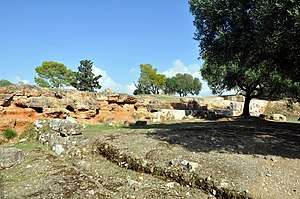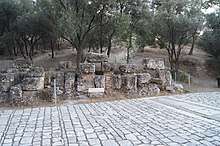City walls of Athens
The city of Athens, capital of modern Greece, has had different sets of city walls from the Bronze Age to the early 19th century. The city walls of Athens include:
- the Mycenaean Cyclopean fortifications of the Acropolis of Athens
- the Pelasgic wall at the foot of the Acropolis
- the so-called "Archaic Wall", whose existence and course are debated by scholars[1]
- the Themistoclean Wall, built in 479 BC, the main city wall during Antiquity, restored and rebuilt several times (under Conon, Demosthenes, Demetrios Poliorketes, etc.)
- the Long Walls, built in the 460s and 440s BC, connecting Athens with its ports at Piraeus and Phaleron
- the Protocheisma, a second wall built in front of the Themistoclean Wall in 338 BC as an extra defence againt the Macedonians
- the Diateichisma, built in the 280s BC as a second line of defence against Macedonian-held Piraeus
- the Valerian Wall, built in ca. 260 AD, partly along the lines of older walls, partly as a new fortification, to protect the city against barbarian attacks
- the Herulian Wall, a much smaller circuit built in c. 280 AD, enclosing the very centre of the ancient city following its sack by the Heruli in 267 AD
- the Rizokastro, built in the 11th/12th century around the Acropolis
- the Wall of Haseki, constructed in 1778 by the Ottoman governor of Athens, Hadji Ali Haseki
The Diateichisma

The Diateichisma wall was built after the battle of Chaeronea (338 BC). It was 900m long and built across the crests of the three hills: that of the Muses, of the Nymphs and the Pnyx. It joined the Thermistoclean wall at north and south and had square and circular towers and two gates. However it cut through inhabited suburbs of ancient Athens, leaving the Demes of Melete and Koile outside the wall and vulnerable.
The south gate in the valley between the hill of the Muses and the Pnyx was for the most important commercial Koile road of Athens which led to the port of Piraeus. Remains of the gate can still be seen. The north Melitides gate was in the valley between the other two hills.
In 294 BC a small fort was built on the top of the Muses hill for the Macedonian guard of Demetrius Poliorketes, using the junction of the wall with the Thermistoclean wall on two sides joined to a new wall with towers.

References
- ↑ For arguments for and against, cf. Weir 1995 and Papadopoulos 2008 respectively
Sources
- Judeich, Walther (1931). Topographie von Athen (in German) (2nd ed.). Munich: Beck.
- Papadopoulos, J. K. (2008). "The Archaic Walls of Athens. Reality or Myth?" (PDF). Opuscula. 1: 31–46.
- Theocharaki, Anna Maria (2011). "The Ancient Circuit Wall of Athens: Its Changing Course and the Phases of Construction". Hesperia: The Journal of the American School of Classical Studies at Athens. 80 (1): 71–156. doi:10.2972/hesp.80.1.0071. JSTOR 10.2972/hesp.80.1.0071.
- Weir, Robert G. A. (1995). "The Lost Archaic Wall around Athens". Phoenix. 49 (3): 247–258. JSTOR 1192524.
- Winter, F. E. (1971). Greek Fortifications. Routledge & Kegan Paul. ISBN 978-0-608154244.